|
FAQs on Bulb, Bubble Tip/Rose
Anemone Health 13
Related Articles:
Bubble
Tip, Rose Anemones, Entacmaea quadricolor, Use in Marine
Systems by Bob Fenner, Bubble Tip
Anemones by Jim Black, Recent
Experiences with BTA's by Marc Quattromani,
Anemones,
Cnidarians, Colored/Dyed Anemones,
Related FAQs: BTA
Disease 1, BTA Disease 2,
BTA Disease 3, BTA Disease 4, BTA
Health 5, BTA Health 6, BTA Health 7, BTA Health
8, BTA Health 9,
BTA
Health 10, BTA Health 11,
BTA Health 12,
FAQs on BTA Disease by Category:
Diagnosing,
Environmental (Pollution/Poisoning, Lighting...),
Nutritional, Social (e.g. Allelopathy),
Trauma,
Pathogenic (Infectious, Parasitic, Viral)
Predatory/Pest, Treatments
& E. quad. FAQ
1, E. quad FAQ 2, E. quad. FAQ 3, E.
quad FAQ 4, E. quad FAQ 5,
BTA ID, BTA Compatibility, BTA Selection, BTA
Behavior, BTA Systems, BTA Feeding, BTA
Reproduction/Propagation,
|
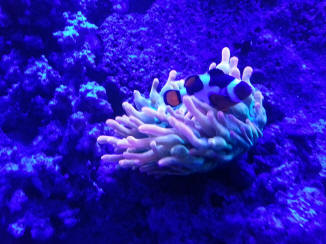 |
 |
New Print and
eBook on Amazon:
Anemone Success
Doing what it takes to keep Anemones healthy long-term
by Robert (Bob) Fenner
|
|
Bubble Tip Anemone Question
11/20/19
Hello again, Sorry to bother you again, but I have a question. (this is not the
anemone that got sent to me by mistake and then died. I had this one first and
it was doing very well. ) I have a tank Raised BTA,.... it was doing very well
for a while,....then it started looking uninflated more and more often. Now I
have seen it poop, so I believe it's eating enough of the Frozen thawed mysis
shrimp I feed the tank with daily. It has never taken food from me dropping it
onto the tentacles,...it never holds on to it so it just floats away.
I guess I'd say it is not sticky? Which seems strange to me. They are supposed
to be sticky, right? So they can grab food?
<Yes. Non-sticky tentacles are a bad sign>
I had a pair of tank raised clowns that loved on it,...I got them a month after
the anemone so it would be in good shape before I got them.
<Good move>
They did well together for a while,....But recently it just doesn't seem happy
at all It has started moving around,....I could watch it go.
<A moving anemone is an unhappy anemone>
And when I asked the breeder he said maybe the clowns were too rough on it so I
gave my female
clown to a friend and only kept the little male. He loves it too. Nuzzles it and
protects it all day and night. That said, removing the female didn't help. It is
still smaller and very brown and not very inflated ever.
So, in the last few days it has climbed up the glass to the top of the tank,
...I think to get more light. So I have put a light above it's spot, an extra
LED light.
<Good... are you able to borrow a PAR or PUR light meter? These animals need
quite bright illumination>
It seemed to like that and opened up and faced it. I was happy! But during the
next water change it was hanging in the air!
<Mmm; not a good idea>
I only did half as much water as usual and hurried fast to cover it back
up,....and it did sort of slide down a little bit, but not enough so that I
could do the whole 30% water change....so I waited hoping it would move lower.
It never did.
So, I had to remove it from the top of the glass in order to do the next water
change,....So I used a silicone very slender and smooth spatula to slide under
it, let it drop in to a cup and then put it back on the bottom again near where
it had started.
<Neat application>
It looked ok that night,....but then the next day it turned over up side
down,....then righted itself again but crawled into the back corner of the tank.
MY question is, did I need to remove it from the top of the glass when I did the
water change?
<Yes, I would not expose anemones to the air any more than necessary>
Or could I have left it there, it would have been in the air though, not in the
water. I thought that would kill it! But now I read on your sight that moving it
would kill it!
<Better not to move them if you don't have to.>
He is not fading in color at all, he's a deep brown color,....he used to have
beautiful green coloring, but now just dark brown.
<Ahh, not enough intensity, wave length, duration... of light>
All of him. His base is lighter when he's expanded. But in general all his
beautiful coloring he had when he got here is gone. I read somewhere that
phosphates in the water can increase the number of zooxanthellae in the corals
and that makes them look brown instead of showing their pretty natural pigments.
I did test for Phosphates and it was 0.50,...hopefully the big water change, I
did about 40% and also cleaned both filters,....(not cleaned with fresh water,
just with tank water,.....they were dirty!) should help the phosphates. I also
ordered SeaChem's Phosphate remover. In case that might be the problem.
<You do want/need some HPO4>
I also added some Charcoal pads to each filter, to help with the water
quality,...don't usually use charcoal in my reef tank. I guess I am worried he
isn't expanding his tentacles out like he did when I first got him. And that is
a sign he is dying.
<May be>
It's funny, back when I first got him, he was in a 13.5 gallon tiny reef tank! I
moved everyone a 55 gallon and he has never been the same. I guess he like the
little tank, he was closer to the light then. I don't have any large rocks that
pile up high....I like my tank to look like the top of a reef, not a whole reef.
So I spread out my rocks in a single layer,....I guess that's not so good for
him maybe.
<I would make a bommie, stack of rock that goes about half way up for this
animal>
I have ordered one large piece of man made reef rock that is very tall....I will
put it near him when it
comes It's just dry rock.
<Ahh! Fine>
I'm going to attach a link to a short video of him that I posted to Facebook
Maybe if you see him you can tell me what to do to help him. Does he look
miserable to you too? He sure does to me. Here is the link.
https://www.facebook.com/Ingrid.Mandy.Wilson/videos/10219844361516180/
Thank you,
Mandy in NJ (again).
<Might be that the profuse pulsing corals are outcompeting the anemone
(allelopathy). I would try some other food items... placing them near the mouth
(with tongs)... Perhaps silversides or fish fillet, a bit of large shrimp
(uncooked). All else looks very good/healthy! Bob Fenner>
Re: Bubble Tip Anemone Question
11/20/19
My reef base rock from Seachem came tonight! I can't believe Amazon,... they are
so fast!
<Ah yes; an excellent company>
Tomorrow I will put it in as a stack....It's a rough kind of base rock,...
I hope it won't be uncomfortable for him to sit on.
<Should be fine>
But we'll make it high enough that he won't have to cling to the glass To get
close enough to the light, that must me hard for him, glass is slippery.
Thanks for the advice again!
Mandy in NJ
<Cheers, BobF in Ca. tomorrow HI>
UPDATE: Bubble Tip Anemone Question
1/25/20
Hello Mr. Fenner! I am writing to tell you that my BTA is not only doing
well now, thanks to your advice, it is thriving!
<Yay!>
Thank you so much for helping me save my clown fish's best friend in the
world.
<Welcome>
I added the rock to make it sit up much higher, and it's in the back where
it gets wonderful morning sunshine.
<Ah good>
I also have a power head that drives my frozen Mysis gently down on him and
the clown fish. Thank you again for all the advice and sympathy (when
something doesn't make it) over the years.
Pictures from this morning.
Yes, that is a Rainwater Killifish,...I believe you all helped me identify
it. It's blurry, but it is doing very well!
Amanda Wilson in NJ
<Cheers Amanda. BobF>
|
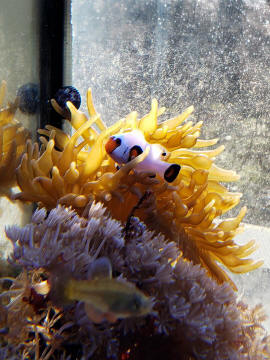 |
|
My Bubble Tip Anemone Split! 2/13/20
Dear Bob Fenner,
<Hey Mandy>
The Bubble Tip you helped me save got really big and this evening I now have
two!
<Ahh!>
My poor Clownfish is so confused! LOL! He's trying hard to love on both,...
but they are a few inches apart, so he's having a hard time.
I am so thrilled!
Now there are two! Nature is so amazing.
<Indeed>
Thank you again for helping me save his life.
<Glad to have helped you; in turn it is you who saved this life. Bob Fenner>
Mandy in NJ
|
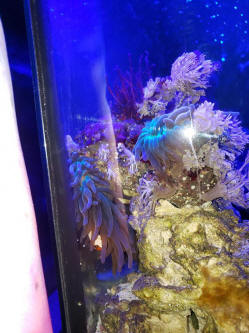
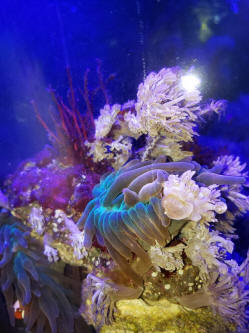 |
|
|
Treat bta with Cipro? 2/4/18
Hey Team!
<Jen>
I have a bubble tip anemone and need advice. I originally assumed it was an
aquacultured specimen but later realized I was dealing with a wild import.
<... I have never seen an Entacmaea like this... it's been artificially colored>
Unfortunately before I knew better, I parked him in QT with my 5 year old clone
of another BTA and a 9 year old live rock.
<? Why, what purpose in placing these together in quarantine?>
I assumed because I had one nem that did very well with me for years, I didn’t
think for a second about researching issues with adding a second.
<Clones get along; not heterogenetic specimens very often>
After some time (a couple of weeks) he wasn’t looking so good so I decided to
move him to a 9 year old display tank, thinking he needed more stable
parameters. He still was not looking good, and by this I mean deflating often,
expelling brown stringy goo, gaping mouth, color turning brown... At this point
I got in touch with people who deal with bta more than I do and found out it was
more than likely a wild specimen and it was suggested I obtain Cipro and
separate the bta to a different system (this display: 3 years old, very few
corals) without other anemones.
<What? Of what use would this antibiotic be?>
I ordered Cipro and moved the nem. For a little while the anemone looked like it
was stabilizing and it was going to improve. Meanwhile I got mixed input from a
few others on whether to treat with Cipro or not. Everything from all wild nems
should be treated with Cipro to Cipro treatment only as a last result, to if you
start Cipro, it will die.
<... do you have a citation re this?>
Knowing anemones flush their systems, and still being on the fence about
treating or not, I moved the anemone to a qt tank again after he decided to let
go of the rock and drift and decided to do 100% water changes daily in hopes of
he would remove whatever it was that was bothering him. So far it’s been 2 days
12 hours and I’ve been using the dirty anemone water as a water change for the
display tank in hopes of helping the inhabitants to become familiar with the
anemone. Sorry for pic heavy email, wanted to show his story in hopes of helping
him recover. Using ESV salt, rodi water, temp 77.5, powerhead moving the water
for 24 hours or more before it’s used. Suggestions?
<I don't know what to write here.... I would not treat this animal further, but
just leave it be; hope it stabilizes.>
Thanks so much for all you do,
Jen
Arrival 2 months ago, cold shipping water I thought that was the cause of it
all. Going into QT with a Rbta clone:
It had put off a clone (didn’t survive) and started losing color in first
display tank (it was with the other clone anemone at this time), was deflated
often, gaping mouth:
Anemone now in second display tank (with limited Corals and no other anemones)
attempting to eat TDO medium pellets. It appears to do worse after feeding.
It let go of the rock and went for a float. After he couldn’t find a
satisfactory location I removed him to QT.
I believe that’s a mesentery filament in the tentacle. They later start to
appear outside the “skin”
Fed a small amount of Reef Nutrition ROE, invest some:
Mesentery showing after performing a water change:
Early Morning #2
About 1 hour later:
Afternoon #2 attempt at feeding a very small amount of LRS fish eggs. After a
long time it finally ingested, an hour later spit out in a sack. I removed and
performed water change with new water:
Night of day 2, was floating upside down, gently held it near the rock and it
grabbed on:
<All very strange. Bob Fenner>
|
.jpeg)
.jpeg) |
Bubble tip; hlth. 1/6/18
Hello,
<Sheldon>
On my baby BTA I have noticed what look like small white specs/calcium
deposits on the tentacles,
<Ahh; have seen such bits from time to time; in captive specimens and
wild.
Don't know what they are...>
where it split from the mother BTA. This baby anemone was once a part of
a 60+ CM bubble tip. The
original BTA is clear of the white markings. The baby is about a year
old, growing and seems quit healthy.
Are these specs harmful?
<I don't think so; have known them to persist in aquarium, aquacultured
specimens, and just as likely fade away in time. I would not panic>
Thank you,
Sheldon
<Welcome. Bob Fenner>
Re: Bubble tip 1/6/18
Thank you!
<Welcome!>
|
Opaque BTA tips? 12/12/17
G'Day guys,
>Dave<
Just saw Bob Jenners talk on Anemones from MACNA via YouTube.
Quick question....
I have several green BTAs that have slowly developed a whitish opaque look to
their bubble tips similar to the photos below.
<Happens at times>
Wondering if this is a sign of ill health or if there is something I should be
doing to correct it.
<Don't know the root cause here, what it portends, but would initiate iodide-ate
dosing and check overall water quality.>
I've kept these anemones for 3 years and they seem quite happy. Never move
around, they have multiplied several times and have the tank to themselves with
the exception of one pair of ocellaris clowns.
<Ah good>
They get a single Anemone pellet from Vitalis each once a week.
<I'd up this to one twice a week>
Any reply would be much appreciated.
Dave McAuliffe
Western Australia
<Bob Fenner>
|
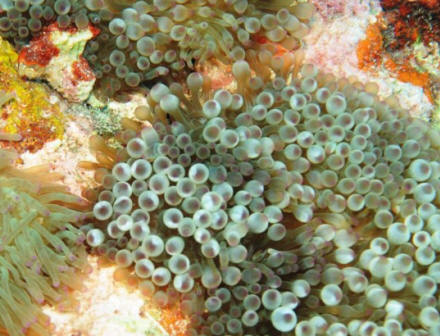
Re: Opaque BTA tips? 12/13/17
Thanks a million for the reply Bob,
I enjoyed your talk at MACNA.
<Ah, thank you for your kind words Dave. BobF>
Dave
|
Bubble tip anemone Eating its tentacles
10/4/17
Hi team
<Matt>
Absolutely great site by the way. I have kept bubble tip anemones for a
few years now and I'm hoping you can help me with something that has me
completely stumped. The anemone (E. Quad) in question is in a 2 foot
cube
with a few other bubble tips
<All clones I trust>
and a pair of clowns and a mandarin (refugium). It is a few years old so
well established with stable reef
parameters. The only change in the last few months is i did a small
rescape just moving a few rocks and did not disturb the sand. All
anemones seem to be in perfect health except one which i have been
observing it place its
tentacles in it's mouth and sucking the ends out of the tentacles and
pulling long strings out of them this seems to happen frequently and now
the anemone although it expands well used the tentacle pattern is now
irregular and half of the anemone has short fat tentacles. It still eats
and is under high powered led it grew and thrived under. I'm not sure
what the cause is (possible bacterial infection) as the system is just
anemones and 3 fish so rules out chemical warfare. I cannot find an
answer anywhere and I'm extremely knowledgeable on this particular
anemone. It is literally chewing off the end of it's tentacles.
Thanks in advance
Matt
<Have seen this before. Sounds/reads like manifestation of "Old Tank
Syndrome". I would move the mal-affected BTA elsewhere, stat. Bob
Fenner>
Re: Bubble tip anemone Eating its tentacles
10/5/17
Hi Bob,
<Hey Matt>
Thank you for your response. If i could just pick your brain a bit more
and get a little more clarity on the issue.
<Sure>
Firstly have you observed/heard of this behavior of a bubbletip taking
it tentacles to it's mouth and extruding filaments which it seems to
digest?
<Yes I have... mesenterial filaments are about all the insides of an
anemone that there are>
If so what is the purpose of this?
<I consider it to be a pathological event. An indication that
something/s wrong>
Is there any benefit to the animal?
<I doubt it. Seems self-destructive>
The only thing that comes to mind is it's feeding of the Zooxanthellae
or rearranging the population or it's starving.
<An interesting speculation>
The next question is you say it may be old tank syndrome. What gave you
the impression?
<OTS is such a general expression... what could be the cause/s here?>
Rearranging the rock kicking up detritus?
<Perhaps a factor>
The reason I'm asking is to prevent any other anemones from declining. I
have heard people say "old tank syndrome" (By no means in regards to
your earlier response) when they can't pinpoint the root of a problem
and have come across different theories as to what old tank syndrome
means.
<I'm one of those folks. Have recently re-read my several hundred pound,
thousands of hobbyist magazines; including a later piece in AFI
(Aquarium Fish International) re OTS>
Anywhere from excess nutrients built up in rock and substrate leaching
back into the system to and imbalance of elements or bacterial
populations.
<Ah yes>
I am religious when it comes to water changes and this system get at
least 10% weekly and clarification on this will tell me the best way to
proceed and prevent healthy anemones remain that way for as long for
many more years to come.
<You are wise here; or should I state, that you and I's philosophies and
practices appear confluent>
Once again thank you for you time and knowledge.
Matt
<Glad to share. Thank you. Bob Fenner>
Re: Bubble tip anemone Eating its tentacles
10/5/17
Thanks Bob,
<Welcome Matt>
One last question In the cases you are aware of does the decline Spell
the end of the animal or can this be reversed and a healthy specimen or
is my anemone doomed no matter what i do.
Matt
<If memory serves, there are few incidences of survival>
Fwd: Bubble tip anemone Eating its tentacles
10/25/27
Hi Bob,
<Hey Matt>
I thought i would give you an update and share for the benefit of the
readers. I'm happy to say the anemone has turned around and stopped it's
self destructive behavior of eating it's own tentacles.
<Ah, good>
This happened after i rescaped my tank as per my first message and i
have since discovered it was in a hot spot under my leds. It's quite
interesting because rather than expelling Zooxanthellae and bleaching it
the anemone shed it own mass instead. Although it's recovering slowly
I'm not out of the woods but very glad to say i have not observed any
filaments consumed by the anemone and i have high hopes for a full
recovery.
Many thanks,
Matt
<As many welcomes. B>
|
Attn, Bob... Report: Dyed "Sherman Rose" BTA!
6/28/17
Hey ya'll, Sean Morris, down here at Acadian Mariculture (what I am now calling
my marine breeding operation, hehe)...I was trying to make my true perc
broodstock happy because my last two clutches weren't... well.. alive
for long...and so my LFS who I do a LOT of business with, had these beautiful
"Sherman rose anemones" ... purple disk, dark brown base, pink tentacles no
green showing at all. I recently recovered a bleached gbta from
there, so my water quality isn't a problem... again... I breed true percs.So my
wife bought one... and it hasn't been doing well (thought it was due to quick
acclimation)... so I went and bought another... did a 3 hour acclimation...
brought it home in an ice chest...bought two gbtas with it...-I want my mama
percula to imprint on rose and regular so the babies will take to both. at least
that was my plan-Well... today, after waking up to the three new anemones
looking perfectly happy... ... this first Sherman is still showing the same
symptoms:-tentacles sticking together, sticking to algae, bacteria.-overly
frequent defecation of body-colored bits.-enarging at night with mouth
open-color fading, turning white in some spots, brown in others-as sensitive to
hands in the tank as a ritteri(whereas most btas, you can touch and they don't
care, this one shrivels when I pull have a finger in without vinegar soaking,
and even then, its only a matter of time)-and now, today... a green tentacle.
just the one?
<Mmm; they can/do change color/s at times>
A single green nub, surrounded by pink and purple... cant really see it well in
the photo, but I tried. one green tentacle...for now...but the bleached areas
seem to be showing a little green, as well.i will more closely document the
progress of the other, formerly identical, specimen, and post progress on my
YouTube channel, The Lost Begotten. Feel free to check it out ;)-also filming an
ultimate anemone guide series, so you may find that helpful.
<Oh yes; my pitch/presentation this year (August) at MACNA is titled Captive
Anemone Use. Do make it known when and where this is posted>
In addition to my 30yrs exp, this past weeks panic has made me update my
research-base, and I feel like I've got some complete info that needs sharing.
For now, I had to let you all know about this, apparently, dyed RBTA...
makes me wonder if Sherman's are all dyed. It would be sad, but not
surprising, if con-artistry had become so elaborate.
<I don't know re Sherman... some folks postings on the Net speculate they might
be.>
Welcome to Trumpland.Thanks again for all your helpful info. Peace-Sean Morris
(Baton Rouge, La)
<Thank you for sharing. Bob Fenner>
|
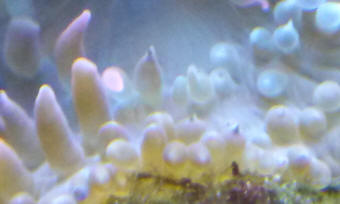
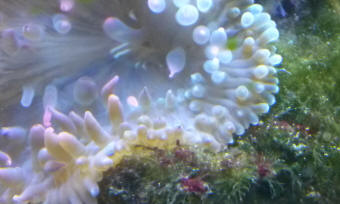 |
Rainbow BTA not doing well after tangling with Bristleworm
5/1/17
I have a 29 gallon,
<Mmm; large Indo-Pacific Anemones need (much) more room than this... Too
unstable...>
with 165w full spectrum led, 8 month old tank with a RBTA, one clown,
one Firefish, one cleaner shrimp, one peppermint shrimp,
<Shrimps may be eaten by the Anemone in time; as well as the Firefish.>
frogspawn,
<Incompatible... too allelopathogenic w/ the Anemone>
a small maxima clam, scan,
<? Acan?>
pulse and Sinularia. Everything is doing well except the BTA.
<Losing; per the statements above>
One day about a month ago I woke up to find some bristles stuck in her.
She was deflated, disc shaped, I removed the bristles and hasn't
reinflated
since. She is getting smaller and eating less each day. We try to feed
her krill and shrimp but she isn't really interested.
<... how small are the pieces?>
Now she has moved about a half inch closer to the light and will react a
small amount when the lights are on.
Nitrates 0,
<.... sigh; all chemosynthetic life NEEDS some N, P, K...>
nitrites 0, ammonia 0, ph 8.4, temp 76.2. Is there anything I can do for
her?
<Please read here:
http://www.wetwebmedia.com/marine/inverts/cnidaria/anthozoa/bubbletipanemones.htm
and all the linked files above. You've set yourself up for failure here;
do educate yourself>
Thanks!
Jill
<Welcome. Bob Fenner>
Re: Rainbow BTA not doing well after tangling with Bristleworm
5/2/17
Sad, since LFS and online forums have told us all of these were fine
together in a 29 gallon.
<... I do understand. Take a look where I've referred you; or see my
book on captive husbandry of Actinarians... or catch my pitch at this
year's MACNA... on the same topic>
We have tried various sizes of food ranging pea sized to grain of rice
size and she rejects all food.
<Allelopathy.>
We have a 75 gallon in the works but that is a couple weeks off before
we can begin the cycle. I will move the frogspawn to another tank is
there anything else that can be done?
<Reading... the use of GAC for now, perhaps overdosing iodide-ate>
Is the Acan bad also?
<Not as much so; no>
Also I forgot to mention a small sun coral
<Tubastrea likely; also moderate. B>
that is also in the tank. Thanks for the link.
Jill
Re: Rainbow BTA not doing well after tangling with Bristleworm
5/2/17
The link does not work.
<... it does for me... you likely didn't take out the carat....>
Thanks!
Jill
>
http://www.wetwebmedia.com/marine/inverts/cnidaria/anthozoa/bubbletipanemones.htm
Re: Rainbow BTA not doing well after tangling with Bristleworm
5/2/17
Sorry to bother you, I have one more question. Is the frogspawn
ok if it is on the opposite side of the tank?
<See WWM re Euphyllia compatibility>
The anemone is currently on one end and everything else is at the other
end.
<Smaller specimens/colonies, larger tanks... less chemical warfare. B>
Thanks!
|
Anemone Behaviour... Cause? 2/28/17
Good morning,
<Hey Dave>
I have a 60g tank with 3" aragonite bottom, 55lbs flat live
rock for eventual coral placement, protein skimmer, 2 x Kessil 360's on 9.5hrs
(1.5hrs are 5% intensity blue lights, that ramp up to 60% intensity), 78F, 1.025
salinity. I have two pumps circulating my filtration chamber at 10X/hr, and I
have an MP40 on 40% power a variable Nutrient Export setting
that switches up the flow every 45mins (this adds another 27X/hr flow rate). The
tank is 3months old, and my store had a rose bubble tip anemone that had
recently split and was selling the new addition at $40 which I thought was a
steal so I bought it two weeks ago.
<Mmm; a comment here for all would-be anemone keepers: Better to have "more
seasoned" (older, established settings) than newer>
My water parameters have always shown ammonia/nitrite/nitrate at 0;
however,
<Oh! DO need some (measurable NO3, AND P and K....); anemones are chemosynthetic
to a large degree>
given my hair algae I perceive I have a little nitrate/phosphate that's feeding
the hair algae but still shows untraceable amounts. I've read through your two
main articles on BTAs, and I'm curious about the 7-14 day feeding
regimen recommended there. How much for a small BTA?
<Twice a week... let's say, meaty food equivalent (bits) of half your last pinky
segment in volume>
I have purposely let thawed mysis or brine fall on the BTA's tentacles and it
doesn't seem to draw the pieces in. I've seen my Percula Clown bring the BTA
food. Not sure what the BTA is supposed to look like feeding. I should
point out the BTA moved about 5" over night from my original placement and seems
to have secured itself under a ledge in a lowlight area.
<Good; don't move it>
If the BTA were to move above the ledge it would be in a very will lit area, and
I'm assuming that given it hasn't moved since day #1 that it is happy where it
currently resides - otherwise it would move?
<Needs chemical nutrients; remove your chemical filter media (if using) and turn
your skimmer down or off for half the day>
Three days ago, my BTA looked like this (picture attached), about 45mins later
it looked normal. First thing this morning, my BTA looked like this again.
Someone on a forum indicated this was normal behavior, but I wanted to ensure
this was the case.
<They (Actinarians) do expand, contract to degrees>
Given my clown is over half the size of the BTA, I was curious if the clown
might be harassing the BTA too much? Thoughts?
<Mmm; not this species.... the smaller clownfish are generally not trouble in
this regard. IF you see, expect otherwise, place the clown/s in a floating
plastic colander for a few days... see if this helps. IF it continues, fashion a
plastic mesh over the anemone (straw- et al. berry baskets work well here)>
In particular, I'd like to know how much food is appropriate on a one or two
week direct feed schedule. I also feed my tank Oyster Feast and PhytoFeast (one
of them) twice a week for the feather duster, colt coral, star polyps,
and Zoas.
<Oohhhhh; the soft coral, Clavulariid and/or Zoanthids... may
well be winning a/the chemical allelopathy war here. Do you have another
established system you can move the Entacmaea to? I would. Bob Fenner>
Dave
|
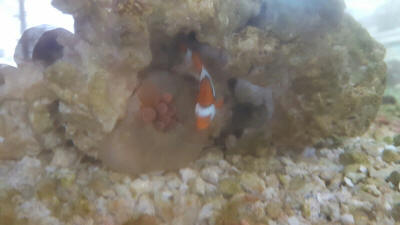 |
|
Re: Anemone Behaviour 2/28/17
I should add, the star polyps are upper tank range and a good 18" or more away.
<Yeah....>
I have three small heads on my Zoa frag that is nearly two feet away. The colt
coral is at the opposite end of the tank almost 3' away.
<Uh huh... notice I wrote "chemical", not physical... they don't have to
be anywhere near; just in the same water. Have you read my piece, ppt
on avoiding Cnidarian warfare? My bit on "Boris Karloff-ing" by mixing water
to/fro...? See here:
http://www.wetwebmedia.com/CorlCompArt.htm
I would say the coloration of the BTA has, if anything, improved since my
acquisition showing deeper red and greens. Aside from this 'enclosing the
tentacles' behavior that I am unfamiliar with, I'd say the BTA appears to be in
great shape. I guess my question was regarding feeding, and if the 'enclosing
the tentacles' was normal. Am I correct in saying the 'enclosing of the
tentacles' occurs for either feeding or protection perhaps while sleeping?
<Seems to be all unrelated... Night dives find them mostly open.... just when
the current or too brisk, or something is physically bugging them do they close
in the wild>
Yes, I had read 6months or more in an established tank for anemones; however, my
soft corals have been doing excellent and I'm a fanatic over water changes and
keeping my tank as pristine as possible.
Dave
<Do you attend the MACNA do's? My pitch (okay presentation; better connotation)
this year (August, in New Orleans) will be on Anemone Use in Captive Settings...
I have a short book w/ about the same title as well.
See Amazon re. Bob Fenner>
Re: Anemone Behaviour
I will for sure have a read and add your book to my "Fenner collection".
<Heeee! Yours is likely larger than mine!>
Chemical warfare, right... but yet I hear of so many people that successfully
keep both and in smaller tanks.
<Yes; just need to be "properly introduced">
On your BTA anemone section of the website, you also have two articles from
other writers who were guiding me to the every 7 to 14 days for feeding.
<This really is... "enough"; better by far to underfeed than over... Bob Fenner>
|
|
ID. Entacmaea, torn, leaking pedicle/foot.
12/17/16
Hey guys, several of us were wondering what this blue clump is on the bottom
of this Bubbletip anemone. Was seen by a friend at a shop. Sorry I
don't have any more info.
<Yikes, and thank you for sharing Lori. This is part of the animal's
"mesentery" coming out from a torn foot. VERY/TOO common; occurs when
they're removed from the wild most often... from too hard and fast pulling,
jabbing at the animal's base to remove it from hard substrate.
Almost always a harbinger of doom for the specimen. I mention this
in articles on selection, oh, and a book (on Amazon) re Anemones, use in
aquariums. Please begin reading re here:
http://www.wetwebmedia.com/BTAHlthF11.htm
Thanks,
Lori. Johnson.
<Cheers, Bob Fenner>
|
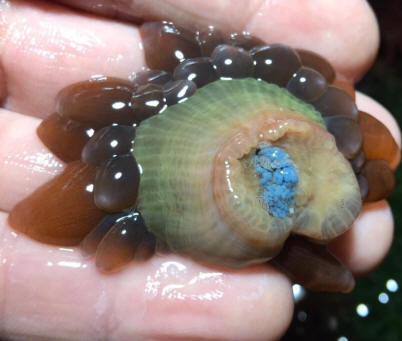 |
|
question regarding bubble tip anemone
7/28/16
Hello,
<Maria>
I am writing in order to see if I could get some guidance/help regarding mi
bubble tip anemone.
I currently have a Boyu TL550, 130 lt, saltwater aquarium.
I placed my E. quadricolor 3.5 months ago, and for the first 2 months she did
great (I am attaching a picture from when she looked healthy).
Since 3-4 weeks ago, the anemone has progressively lost her
''bubbliness'', and the tentacles have ''shriveled'' and look flaccid and
''thin''. The colour has also changed; from a bright orange, to a
darker orange-brown and some sectors even look greenish. 1-2 weeks ago the
anemone decided to close (similar as when lights are off), and has decided to
stay like this for days. Today, she opened, but after 2 days of being closed. I
have two
Ocellaris clownfish, the female resided in the anemone, the male resided in
an Euphyllia.
<Aye ya... here's some trouble>
Now they have both moved to the Euphyllia, however the female goes back to the
anemone any time she exposes her tentacles.
I have never fed the anemone, except for 2 weeks ago (she was
already looking shady) with a mix of brine shrimp and saltwater and squirted it;
there was no change.
<Needs to be fed two, three times a week>
I have checked my parameters, temp is 24-25 C, pH 7.9-8.1, density
1.021-1.023
<S/b 1.025-6>
(they are pretty steady). I recently got more parameters, and the only parameter
that was not right was nitrate (20 ppm). Nitrite, ammonia, phosphate, calcium,
dKH were ok.
<? Meaningless w/o actual data, numbers>
The rest of the aquarium looks fine (other residents are Rhodactis, Kenya tree,
Parazoanthus gracilis, 2 Ocellaris, Sixline wrasse yellow watchman goby,
Salarias fasciatus, 3 hermit crabs, 3 snails, 1 Lysmata amboinensis).
If you could guide me in this issue I would be most appreciative.
<Well; as stated above; the Euphyllia is winning here, the Entacmaea
losing (allopathically); this animal is starved, and the environment? Did you
review BTA Health on WWM? All this is gone over and over... As are
suggestions for improving the situation... moving the Caryophylliid or
Actinarian (they need to be in sep. systems); foods/feeding... and
improving the animal's world. Bob Fenner>
Thank you very much!
|
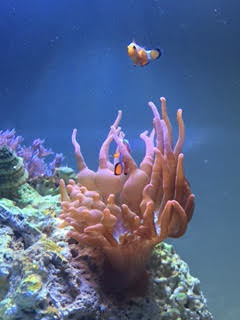
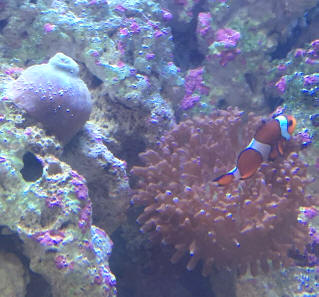 |
|
Sick BTA... 15 megs.... 5/3/16
Resize and re-send. Deleted.
Sick BTA... using WWM 5/3/16
> Dear crew,
<Eric>
> My previously healthy bubble tip anenome <sp.> recently has been looking
sick with malformed and twisted tentacles. I have enclosed some
pictures. Any idea what is going on with it.
<..... no reading... we're not a bb>
I could not find it information myself. I've pasted pictures of the
anenome below. My Parameters include nitrates
below five, calcium 410, alkalinity 3.76 meq/l and a pH of around
eight(I have a really hard time reading either the Salifert or the
Seachem test kits, but the color is a approximately stable over time)>
<These are fine... need some HPO4 and NO3...>
> Any thoughts?
<Other life present? Is this BGA on the substrate? Use of supplements?
Maintenance routine....>
Thanks a lot
> Eric
<Yeah; read here:
http://www.wetwebmedia.com/BTADisDiagF.htm
and, yeah, the linked files above. Bob Fenner>
> Sent from my iPhone
|

.jpg) |
|
Anemone Alerting 10/23/15
So I am sending this just prior to attempting removal of what, I fear,
is a doomed rose bubble tip anemone.
<Mmm; does look bad.... bleaching, losing integrity; though not quite
decomposing just yet.... this last can occur quite quickly, w/in hours>
He was a special order from my lfs. He seemed healthy in the dealers tank for a
month prior to purchase. Should he be removed immediately?
<Tough to state. I REALLY don't like giving up on life... IS there somewhere
else (a holding system, separate) that you can place this animal?>
The lfs told me they feed him krill
<... dismal. See WWM re BTAs>
and that he ate regularly. He has only been in my tank for 24 hours. He was
acclimated then he moved to the spot in the picture, under a rock. I don't want
to jump the gun but I had a disagreement with the seller because I
thought the animal looked bleached.
<It is>
They insisted to the contrary that rather it was merely a lighter colored rose.
<...>
To their defense he didn't gain or lose any color, but consistently "not rose".
He is anchored in the rock but has some slimy discharge, I think. Is this a
bleached specimen?
<Won't state a third time>
I admit I felt pressure to purchase because they don't stock the rose bubble
tips. Will it detach from the rock if it succumbs?
<It'll dissolve off>
Should I remove the entire rock right now? The tank parameters are stable but I
don't feel comfortable enough trying to recover a sick specimen. I don't want to
jeopardize the other inhabitants. The pictures aren't good but perhaps you can
give me an idea.
<Bob Fenner>
|
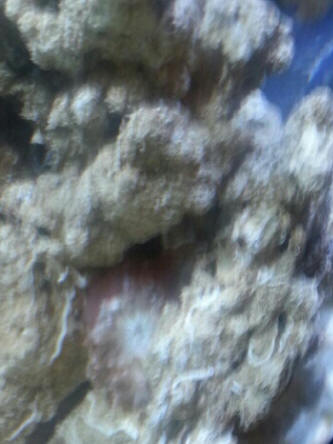
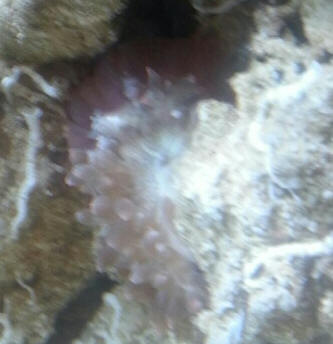 |
|
Bubbletip Anemone Adjustment 9/5/15
As usual I have read and reread the online facts but find myself concerned about
the appearance and subsequent care of a rose Bubbletip anemone. He was added to
a 65gallon reef aquarium last night,
<Is there, are there two anemones here?>
drip acclimated over about 75 minutes to my tank with stable parameters of
1.025salinity, 0nitrite and ammonia, less than 10 ppm nitrate, 8.1 ph, 8.5dKH,
440ppm calcium, temp is 78 degrees F. He was attached to a rock at the store and
is currently tucked into a rock crevice in my tank, with a devoted anemone crab
in tow. He is mildly sticky when touched and did consume a bit of shrimp that
his crab commandeered for him. His mouth isn't open or sagging and he doesn't
have any discharge. Yet he appears, well, unusual, his tentacles are short and
stubby. I assume he is stressed but want to allow for his optimal adjustment. So
I have 2 (Kessil 160) leds and was wondering about appropriate lighting
intensity and period, 20% for five hours for instance?
<.... s/b fine to start>
I was prepared for him to be active in choosing his location but he seems to be
rather passive. Is his current appearance any indication of his tolerance of the
led lighting?
<Can't tell>
Will his tentacles stretch toward the light if he isn't getting enough?
<Not when new to the system; no>
Obviously bleaching is a worst case, best avoided scenario, he came from rather
weak high output fluorescents for a couple of weeks. I brought him home "early"
because I feared the fluorescents would be inadequate. I have owned anemone in
the past and this goofy kind of spread out but not extended look is unfamiliar.
Your assistance is invaluable, thank you, and I will continue to read
and learn.
<Again; your one pic shows another anemone present...or Scleractinian too close
by... higher up.... Not a good idea to mix specimens (unless they are
clones); though this can be done. Do use the two words: Anemone, allelopathy in
the WWM search tool.
Bob Fenner>
|
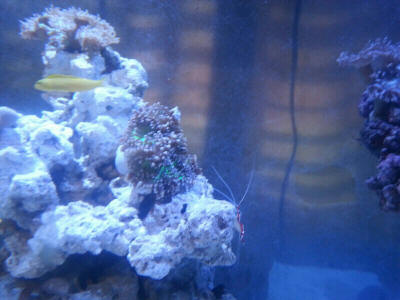
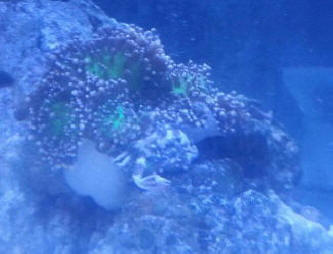 cropped
cropped
|
re: Bubbletip Anenome Adjustment... using WWM
9/7/15
I am responding back to you with hopes you will also view my original email in
regards to the system my bubble tip anemone is in.
<Yes>
My question is that the anenome <Anemone> will not attach to either rock
or substrate but it also doesn't move, at all.
<Likely its foot is damaged. Have you yet read on WWM re Entacmaea? You need to
NOW>
I want to know if there is any method to try and coax it to attach? I am aware
that they tend to migrate to seek ideal conditions, could mine be so weak that
it is incapable of relocation? At this point I would love to see any sign of
life, he looks exactly the same as in pictures. And he is the only anemone.
Should I increase the intensity of the Kessil lights, as suggested they are only
at 25% output for a 5 hour period. Indeed I am perplexed by his behavior, he was
attached to a rock when purchased but easily withdrew and wasn't torn or
injured. Your input is welcomed. How long does he get to hover around before I
fear the worst? He is going in to his second night?
<.... have just skipped down. READ here:
http://www.wetwebmedia.com/marine/inverts/cnidaria/anthozoa/bubbletipanemones.htm
and the linked files above. BobF>
|
.png) |
|
Bubble tip Anemone Fate.... not a reader
9/9/15
Your website is a tremendous resource and I will continue to try and
learn before I ask. I have a rose bubble tip anemone though that I
purchased three days ago. I was concerned about an injury to it's foot because
it does not attach or move about. I didn't want to further stress the animal
with examination but if you think he has had enough time to acclimate (to my
tank) then the lfs has offered to take the anenome
<Still mis-spelled...>
back. I am certain in it's fragile state it would not survive another
move but am my wits end and I can't seem to figure this guy out. I have attached
a picture of his daytime look. The other picture was taken from above with his
foot out to the left oriented kind of sideways, after lights go out. His foot
appears not to be smooth but rather warted with a slight protrusion out the
exact middle of the bottom of the foot. The protrusion doesn't look ominous, not
stringy or sloughing just bubbled? Should I, in your opinion, return the animal?
<You don't know what you're doing; won't read.... Return it>
Can acclimation to my system take longer than a few days? There has not been any
significant change either in behavior or looks but I can't say whether it is
teetering on death or getting used to a whole new world. It isn't withered or
shrunken but it also doesn't puff up and move about? My tank parameters are
adequate to support this animal but not if it has a fatal wound. It's in a 65
gallon, 1.025 salinity, 0 ammonia/nitrite, 10ppm nitrate, 78 degreesF, (2)
Kessil 160 leds, 8.1ph. I want to do my best for the animal, thank you for your
time.
<No reason. Just read. B>
|
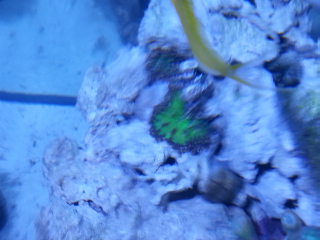
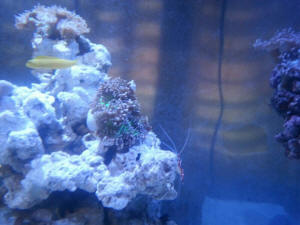 |
|
|
Sick RBTA; using WWM
7/26/15
<WHY not follow our instructions re file size? Am in Curacao; it's taken
min.s to download your non-cropped image of more than two Megs>
Sigh. I know my tank is too small (only 28 gal.
<And obviously too polluted>
I wish I had been told this prior to purchasing & making creature
miserable, if not outright murdering it). I have a JBJ PRO model with LED
lighting: daytime, dusk/dawn & moonlighting Specs list daylight as 25x3
watt 14 k; dawn/dusk: 4x3 watt 466nm; moonlight: 2x1 watt 456nm, so
although my star polyp has grown 5 times original size in 4 months, my RBTA
looks terrible: has not moved since finding its place on a live rock;
bubble tips have shrunk & are dark looking, although lately they seem to be
on the mend, or at least are not black! I have included a pic. Don't mind
the hair algae as I have replaced my skimmer to an AquaMaxx HOB which does
a brilliant job!
<Not yet>
Actually, the hair algae has been 90% reduced! So you can imagine the poor
skimmer quality (was a JBJ that fir into the back compartment...but it was
rubbish!)
<It seems you know the answer to your issue here>
Do you think I can save this little, miserable guy, or should I give him
back to the store from whom I purchased it & perhaps they can help it mend.
Mea culpa. :((
Jennifer Rossi
New Orleans
<Just read on WWM re Entacmaea. Your answers are further gone over and over
there. Bob Fenner>
|
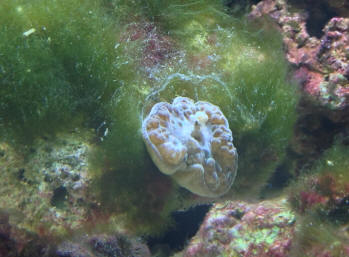 |
|
Anemone Concern. bta rdg. 4/22/15
I had this BTA for the past couple months,
<Was it always this bleached, white?>
it started as a big and wonderful anemone, but it has stopped eating and I cant
get it to eat, its been like this for a while. I've been trying to pipet feed it
mice,
<?>
but i don't think that's healthy. It has been shrinking and I just don't
know what to do.
<.... read>
My salt lvl is at 1.025, everything is zero.
<Oh! Part of the trouble at least... all life, photosynthetic here; needs
measurable soluble N, P, K...>
I've been adding calcium and fuel. i use R/O water and add minerals to the
water. I just don't know what to do anymore....or what am i missing.
<The reading. Start here:
http://wetwebmedia.com/CnidIndex2.htm
scroll down to Entacmaea/BTAs.... Bob Fenner>
Thank you.
|
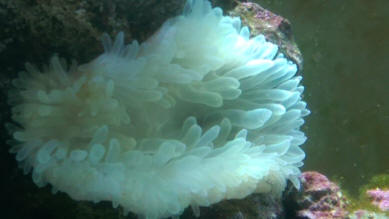 |
|
bleached anemones and lighting... Nine
megs of pix; photography-revelation
1/28/15
Hey guys, just wanted to send a quick note to you guys and thank you for
your website. I recently ran into an issue however and wanted to share
my experience. So first off some background about my tank.
125 gallon Reef Ready custom tank and stand with built in dual stand
overflow and a 50 gallon sump/refugium Orbital Current LED lighting with
Ramp controller Two Hydor Koralia power heads, a 3 and a 4 Reef octopus
XP3000 Skimmer PH 8.0Salinity 1.025Ammonia, nitrites, nitrate,
all 0 ppm
<Essential nutrient>
100lbs liverock various fish RBTA
I had just recently purchased a RBTA for my tank and when it arrived it
was very very small. Less than an inch across fully extended. After
doing the normal acclimation process for it and placing it in the
tank on the liverock. It chose a comfy spot about three inches from
where I placed it and settled in. It has been in my tank for about two
weeks now and has opened up and was showing great signs of health.
Eating well, lots of tentacle movement and extension, the whole bit. I
started to get worried when it seemed like it looked a little pale in my
tank. I wasn't sure how long it really looked that way maybe from the
moment I placed it in the tank. So I started doing research on bleached
anemones. Paid very close attention to pictures of what that looked
like, and asked advice from a few people on local reefing forums here in
my area. I worked myself into a frenzy over this idea that my anemone
was bleached and I needed to do something about it and keep vigilant
with feeding and other recommended steps to nurse it back to health. I
had taken a picture of the anemone and sent it to a few people and all
agreed that my anemone looked bleached and this was a critical time. The
first picture is what I sent, and received confirmation of a bleached
anemone diagnosis from several "experts". For more than three days I
wracked my brain over my bad luck. Including right up until an hour or
so before writing this note. Then it dawned on me...
The camera I had been using had the flash turned off from the last time
I used it. I turned it back on and took another picture of it with the
blue turned down to 10%. The second picture shows the actual anemones
coloration and overall health. The blue and white mix lighting each at
100% was playing games with my camera's color saturation and was skewing
my viewpoint of the anemone, and apparently everyone else's as well.
<Well; photography... is... about controlling light>
So there really never was anything wrong with my anemone at all. I
allowed myself to be fooled by the camera and my own eyes inability to
properly discern the anemones true coloration due to the over saturation
of certain wavelengths of light being emitted by the blue in my
lighting.
So long story short.... Lesson learned. Just thought I would pass this
information along and hope that it helps someone else to properly
diagnose whether an anemone is actually bleached or not. Never trust a
single picture and sometimes even your own eyes to give accurate
information. I see tons of pictures of bleached anemones online all the
time, now the
first question I will ask if I am ever trying to help is, was the flash
on your camera turned on when you took the picture? What percentage of
blue was your lighting set to when the picture was taken.
<You've "traded" (filtered, screened) one part (bandwidth) of visible
EMR for another...>
Have a great day... Keep up the good work with the site.
Steve McQueen
<Still bleached, but thanks for sharing. Bob Fenner> |
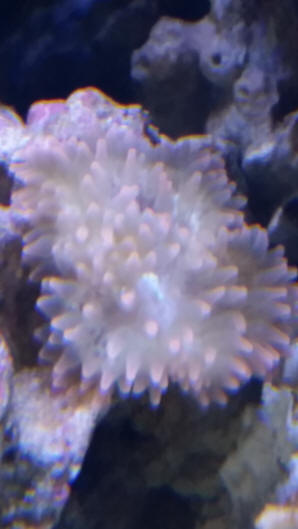
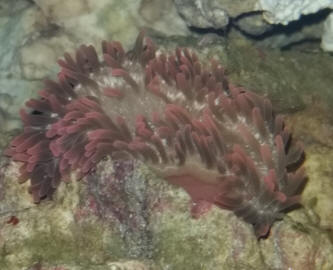 |
|
BTA question.... scarce data, no rdg. 7/13/14
Hello!
<Katelyn; your files are an order of magnitude too large>
First, I apologize if you have already answered my question on your
website. I tried searching through the almost overwhelming amount
of information and I did not find anything
that seemed to answer my question.
I have a 90 gallon tank whose temperature averages between 77-79F and
all
the chemistry is at the appropriate levels (0 nitrates,
<Trouble... chemophotosynthates like Anemones NEED measurable NO3,
HPO4...
this is gone OVER and OVER on WWM>
nitrites, ammonia; little to
no phosphates, slightly lowered carbonate levels but good calcium
and magnesium).
<... data; not subjective statements please>
At the time this problem started, I had a Picasso
clownfish, a Carmel Percula, 2 peppermint shrimp, 2 emerald
crabs, a large number of various snails, and a
BTA (who hosts my Picasso clown). I have
since doubled the amount of live rock in my tank and added a flame
angelfish.
I got my BTA about 6 months ago and until ~4 weeks ago it looked great!
It doubled-tripled in size and looked
beautiful (bubbled tips, nice color, etc). I
put it in my tank and it has never moved since. However, ~4 weeks
ago I noticed when I was home during the day that my anemone
would stretch from it's hole up toward the
surface and then every night settle back into
its hole (see attached pictures taken a few days ago). I have also
noticed more recently that the ends of the
tentacles appear twisted and 2 of the
tentacles have shrunk down to almost nothing. Color still looks good
though, the mouth is still normal, and it hasn't moved. Nothing
had changed in my tank when the weird behavior
started (or within 3 weeks of it
persisting)- same lighting (green element evo quad led), same fish, same
filtration, etc. I had a few days of temperature swings and
fluctuating carbonate levels as we went into
summer (my first with this tank) about when
this started, but I have since worked it out and the anemone is still
acting strangely. Any ideas as to what may be the problem? I
think perhaps lighting but why would it
suddenly become a problem now and not 6 months
ago?
<Lack of chemical (and likely other food); this specimen looks starved
to me>
Thank you very much for you help, I greatly appreciate it!
Sincerely,
Katie M.
<Read here:
http://wetwebmedia.com/BTANutrDisF.htm and
the linked files above. Bob Fenner>
|
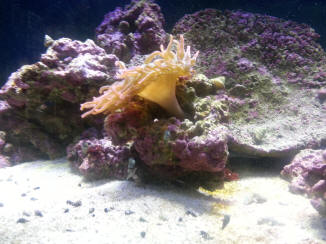
 |
|
Re: BTA question
7/14/14
I apologize in my ignorance in not connecting my anemone's symptoms to
that of malnutrition.
<? No apology necessary. And the statements on my part are only guesses>
A quick follow up- WWM is the only place I have seen that
states a benefit to nitrates and phosphates for
anemones, most other sites
state "none" is the preferred state. What is the
definition of "measurable"
from your previous response?
<A few ppm for NO3... a few hundredths to a tenth for soluble phosphate.
How to put this; these animals are like plants in your yard... suffer
for lack of essential nutrients... N, P, K...>
Is there a certain level I should be aiming
for?
<Yes; gone over... higher 300s ppm to mid 400s>
I assume there is a certain threshold at which point the levels are
detrimental and it presumably is fairly low.
<Ah yes>
Or if there is an article somewhere I have
missed I would be happy to read it for the answers
myself.
<Do give the search tool (on every page) and the indices a go>
Thank you
PS: Here are the numerical values or chemicals in my tank that were
missing
from the last email.
Mg- ~1605ppm
<A bit high>
dKH- 6.7 (I'm aware this is low and have been using buffer to raise it.
I just can't keep the levels high, it seems to
fall within 2-3 days. Working on finding the
best schedule to sustain appropriate levels.)
Calcium- ~500ppm
<Too high>
phosphate- 0.25ppm (perhaps less, the kit wasn't too clear)
Nitrate/Nitrite/Ammonia- all 0ppm
pH- 8.2
Salinity- 1.026
<Cheers, BobF>
|
Re: Clownfish Obsessed with new Feather Duster! Now; BTA
hlth. 2/14/14
Good afternoon Bob!
<Ah yes; Amber>
I wanted to let you know that the Bubble tip anemone shipped in this
week and I have him in quarantine. What an awesome
creature. He didn't look very impressive to start, I was worried, but he
has bubbled up and looks like he is starting to get comfortable. My
question comes in regards to their guts. I have never had an anemone and
know that they exhibit some interesting behaviours.
<Ah yes; oh, BTW have just published a new book on them; e- and print...
On Amazon>
I have been reading Lots in the archive as I always do, and though I can
tell you he is definitely going to be an amazing addition, the shipping
was rough and he still hasn't pulled is 'guts' back in( arrived
wed, acclimated well to qt)... at least that's what I am believing they
are based on what I have read, the difference in what I see though, it
isn't stringy... but like a
ball of white held by a few stringier filaments.
<Yes; mesentery, mesenterial filaments>
His mouth was closed and still the white ball of gut sat there, i
thought... it wasn't attached and used a turkey baster to gently blow it
to see if it was attached. It is... and now I think he is pissed (not
obviously, lol). Is this something he will die with out, it seems to be
trying to release it, not pull it in... I am trying to just leave him be
and be patient. It is very difficult and I am sorry for the new Question
Bob! Thank you again for your time. :)
Amber
<Hopefully will rest up, do fine... wait a week or two and start moving
water from your main/display to acclimate the BTA to the system... and
some vice versa. Bob Fenner>
|
|

